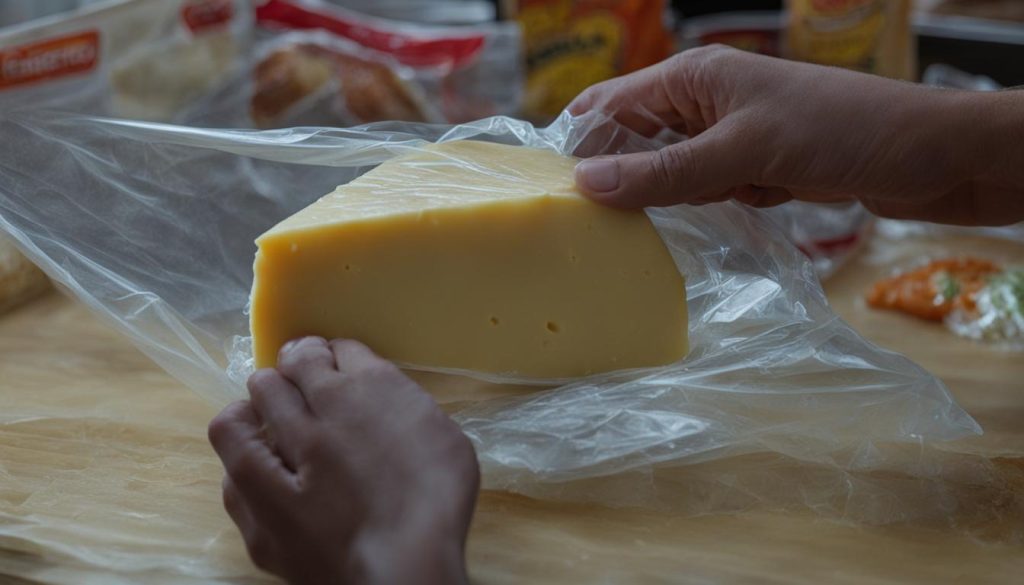Did you know that cheese can be aged for months or even years? It’s true! Cheese making is not only an art form but also a traditional method of preserving milk for extended periods of time. By using bacteria, enzymes, and acids, milk is transformed into cheese, allowing it to be stored and enjoyed long after its original state.
Key Takeaways:
- Cheese making is a time-honored method of preserving milk.
- Preservatives like salt and acids contribute to the longevity of cheese.
- Aging cheese enhances its flavor and texture through enzymatic and bacterial activity.
- Proper preservation techniques are essential for maintaining the quality and safety of cheese.
- Cheese provides a delicious way to consume essential nutrients like protein, calcium, and vitamins.
The Importance of Cheese Preservation
Aging cheese is a crucial step in the preservation process. During aging, enzymes and bacteria continue to modify the proteins, fats, and sugars in the cheese, enhancing its flavor and texture. This natural process, known as ripening, allows the cheese to develop its distinct characteristics and unique taste. Different cheese types require specific storage techniques and ripening processes to achieve the desired flavor profiles.
Proper storage techniques play a significant role in the aging process. Cheese needs to be stored in controlled conditions to ensure optimum flavor development and prevent spoilage. Factors such as temperature, humidity, and ventilation need to be carefully regulated to create the ideal environment for aging cheese. Maintaining these conditions throughout the aging period is essential for achieving the desired taste and texture.
In addition to flavor development, dairy safety is another vital aspect of cheese preservation. The aging process creates an environment that is conducive to the growth of bacteria, both beneficial and harmful. While beneficial bacteria contribute to flavor development, harmful bacteria can cause foodborne illnesses. Therefore, it is essential to follow strict hygiene practices and ensure adequate dairy safety measures are in place to prevent the growth of harmful bacteria and maintain the quality and safety of the cheese.
Storage Techniques and Ripening Processes
Each cheese variety has its unique storage requirements and ripening processes. Some cheeses, like cheddar or Parmesan, need to be aged for several months or even years to develop their complex flavors and textures. Others, such as fresh cheeses like mozzarella, are consumed soon after production and do not require extensive aging.
The storage techniques for aging cheese may include various methods such as cave aging, cellar aging, or aging in specialized aging rooms. The choice of storage technique depends on the type of cheese being produced and the desired outcome. For example, cave aging can create specific environmental conditions that contribute to a cheese’s flavor development, while aging in aging rooms allows for better control of temperature and humidity.
During the aging process, cheesemakers carefully monitor the cheese’s progress, periodically checking its flavor, texture, and appearance. They may regularly turn or brush the cheese to ensure even aging and prevent the growth of mold or unwanted bacteria.
Overall, proper aging and preservation techniques are essential to create high-quality, flavorful cheeses. By understanding the specific requirements of each cheese variety and implementing suitable storage techniques and ripening processes, cheesemakers can achieve outstanding results and produce cheeses that are appreciated by cheese connoisseurs and enthusiasts alike.
Cheese Preservation Techniques
When it comes to cheese preservation, mold prevention is a crucial aspect. While certain cheeses, such as blue cheese, intentionally promote mold growth for flavor development, other varieties require measures to prevent mold from compromising their quality. One effective method used in cheese preservation is the application of a protective coating or wax to the cheese’s surface. This barrier acts as a shield, inhibiting mold growth and preserving the cheese’s integrity.
In addition to using protective coatings, there are other preservation techniques employed in the cheese industry. Vacuum packaging is a common method that removes air from the packaging, creating a barrier that helps prevent mold growth and extends the shelf life of the cheese. Modified atmosphere packaging (MAP) is another technique where the oxygen content in the packaging is controlled to slow down the growth of microorganisms and maintain the cheese’s freshness.
Another widely used approach to cheese preservation is the utilization of preservatives like natamycin. Natamycin is an FDA-approved antifungal agent that effectively prevents the development of mold on the cheese’s surface without impacting the taste or quality. It’s a valuable tool for preserving cheese and maintaining its appeal for longer periods.
Each preservation method has its own advantages and should be chosen based on the specific cheese type and desired outcome. Cheese producers carefully consider the flavor profile, appearance, and texture they want to achieve when selecting the most suitable preservation techniques. By employing these methods, cheese can be enjoyed in its optimal state, free from mold and with enhanced flavor development.
The Benefits of Cheese Preservation Techniques:
Cheese preservation techniques not only prevent mold growth but also contribute to the overall quality and taste of the cheese. These preservation methods ensure that cheese can be stored for extended periods without compromising its flavors, textures, and nutritional value. When cheese is properly preserved, it retains its natural characteristics, providing a delightful culinary experience for cheese enthusiasts around the world.
| Preservation Techniques | Advantages |
|---|---|
| Protective Coating or Wax |
|
| Vacuum Packaging |
|
| Modified Atmosphere Packaging (MAP) |
|
| Use of Preservatives (e.g., Natamycin) |
|
By employing these preservation techniques, cheese makers can ensure the longevity and quality of their products, providing consumers with a wide range of flavorful and safe cheeses to enjoy. Whether you’re indulging in a creamy brie or savoring the sharpness of an aged cheddar, cheese preservation methods are essential for delivering exceptional dairy products to cheese lovers everywhere.
Benefits of Cheese Preservation
Cheese preservation plays a significant role in maintaining the nutritional value of milk. Through the process of fermentation and aging, essential nutrients like protein, calcium, phosphorus, vitamin B12, niacin, and vitamin A are preserved in cheese. These nutrients are vital for supporting overall health and well-being.
One of the remarkable benefits of cheese preservation is its impact on individuals with lactose intolerance. The fermentation and aging process break down lactose, the sugar naturally present in milk, making natural hard cheeses more digestible for people who are lactose intolerant. With an array of delicious and flavorful cheese options available, these individuals can enjoy the nutritional benefits of dairy without experiencing discomfort or digestive issues.
Cheese is a fantastic source of calcium, which is crucial for bone health, nerve function, and muscle contractions. By preserving the calcium content in milk, cheese provides a convenient and tasty way to incorporate this essential mineral into your diet. Additionally, cheese is packed with proteins that are necessary for muscle growth and repair, making it an excellent choice for athletes and individuals looking to boost their protein intake.
Did you know? The American Chemical Society has fascinating information on cheese science and preservation. You can learn more by visiting this informative resource.
The Science of Cheese Making
Understanding the intricate science behind cheese making reveals the fascinating curdling process that occurs, driven by the action of bacteria and enzymes. During this process, different components interact to transform milk into cheese, resulting in the formation of curds and whey.
Lactic acid bacteria play a crucial role in cheese making. These bacteria convert lactose, the sugar present in milk, into lactic acid through a fermentation process. This conversion is essential for the curdling process, as lactic acid lowers the pH of milk, aiding in the subsequent separation of curds and whey.
Another vital component of the curdling process is rennet enzymes. These enzymes modify the milk proteins, specifically caseinogen, turning it into casein. This enzymatic action causes the milk to coagulate and curdle, leading to the formation of curds and whey.
The resulting curds are composed of milk solids, fats, proteins, and calcium, while whey primarily consists of water. The next step involves adding salt to the curds, which flavors the cheese and aids in the preservation process. The curds are formed into shapes, pressed, and then aged, allowing the development of distinctive flavors and textures.
By understanding the scientific processes involved in cheese making, we gain a deeper appreciation for the complex interaction of bacteria, enzymes, and milk components that ultimately give us the delicious cheese we enjoy.
Don’t forget to check out Science Learn’s The Science of Cheese resource for an in-depth look into the fascinating science behind cheese making.
Conclusion
Cheese making and preservation are ancient traditions that have allowed for the storage and enjoyment of milk in the form of cheese for centuries. This age-old practice involves the use of bacteria, enzymes, and acids to transform milk into cheese, which can be aged for extended periods of time, resulting in a rich and diverse array of flavors and textures.
Proper aging and preservation techniques are vital to maintain the quality and safety of cheese. The careful balance of time, temperature, and humidity during the aging process is essential to achieve the desired characteristics. These techniques not only prolong the shelf life of cheese but also contribute to the development of its distinct taste profiles.
Preserving cheese not only extends its longevity but also retains its nutritional value. Through fermentation and aging, cheese becomes a concentrated source of essential nutrients like protein, calcium, phosphorus, vitamin B12, niacin, and vitamin A. Additionally, the breakdown of lactose during the fermentation process makes cheese suitable for individuals with lactose intolerance.
Whether you choose to embark on the craft of cheese making or simply savor the delicious varieties available, cheese is an incredibly versatile food that can be appreciated by all. Its centuries-old legacy and wide range of flavors make it a timeless delight that continues to capture the hearts and taste buds of people worldwide.


